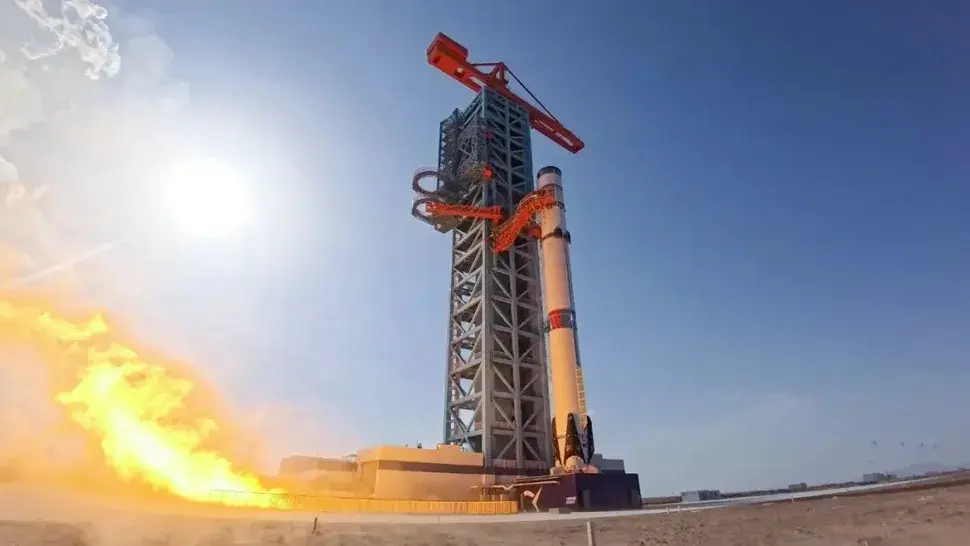China's New Reusable Rocket Roars to Life, Nipping at the Heels of SpaceX
- Tom Smith
- Oct 22
- 3 min read
The global space race just got another serious contender. Chinese commercial aerospace company LandSpace has successfully completed a major static fire test of its Zhuque-3 rocket, a powerful new launcher that bears a striking resemblance to SpaceX's workhorse Falcon 9. This critical milestone, which took place at the Jiuquan Satellite Launch Center in northwestern China, signals a significant leap forward in the country's quest for reusable rocket technology and sets the stage for a debut flight anticipated before the end of 2025.

A Fiery Milestone on the Path to Orbit
So, what exactly is a static fire test and why is it so important? In simple terms, it's a full-dress rehearsal where the rocket's engines are ignited at full power while the vehicle remains securely anchored to the launch pad. This allows engineers to verify that all systems are working together as they should, from propellant loading and engine ignition to a controlled shutdown.
The Zhuque-3's test was a resounding success. All nine of its powerful Tianque-12A engines on the first stage roared to life, generating a combined thrust of over 7,500 kilonewtons (more than 1.7 million pounds of force) for 45 seconds. This test concluded the initial phase of the rocket's maiden flight campaign, which also included a successful fueling test, proving the vehicle's readiness for the rigors of spaceflight.
The "Vermilion Bird" and its Impressive Design
Named after the Vermilion Bird from Chinese mythology, Zhuque-3 is an ambitious vehicle. Like SpaceX's Starship, it is constructed primarily from stainless steel and is powered by liquid methane and liquid oxygen (methalox) — a cleaner and more efficient propellant combination than the rocket-grade kerosene used in many other launchers.
The two-stage rocket stands approximately 66 meters (217 feet) tall and is designed to be partially reusable, with a first stage capable of vertical landings for recovery and reuse. This reusability is key to LandSpace's goal of drastically reducing launch costs—by as much as 80 to 90 percent compared to single-use rockets—with the first stage designed to be reused at least 20 times.
Key Specifications of the Zhuque-3:
**Height:** ~66 meters (217 feet)
**Diameter:** 4.5 meters (nearly 15 feet)
**Propellant:** Liquid Methane and Liquid Oxygen (Methalox)
**First-Stage Engines:** Nine Tianque-12A engines
**Payload to Low Earth Orbit (LEO):** Roughly 18,300 kg (40,350 lbs) when the first stage is recovered
This payload capacity places it in a similar performance class to the Falcon 9, positioning LandSpace as a formidable future competitor in the global launch market.
A Series of Successful Leaps
This static fire is the latest in a string of impressive achievements for LandSpace. The company has already conducted several vertical takeoff, vertical landing (VTVL) tests, often called "hop tests," to validate its landing technology. In a remarkable test in September 2024, a prototype vehicle flew to an altitude of over 10 kilometers, cut off its engine mid-air, and then successfully reignited it during descent to perform a soft, precise landing.
LandSpace is no stranger to making history. In July 2023, its predecessor, the Zhuque-2, became the world's first methane-fueled rocket to successfully reach orbit, beating American rivals like SpaceX and Blue Origin to the punch with this next-generation propellant.
What's Next?
With this successful engine test in the bag, LandSpace will move on to vertical integration rehearsals before preparing for the inaugural orbital launch. The maiden flight of Zhuque-3 is expected in 2025 and will include an attempt to recover the first stage. This rapid development pace highlights the intense competition and innovation blossoming within China's commercial space sector. If successful, the Zhuque-3 will solidify LandSpace's position as a major player and further accelerate the new era of affordable and sustainable access to space.






Comments